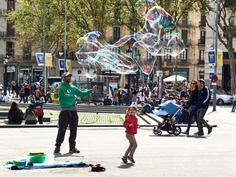Latest News
6 Placemaking Strategies to Revitalize Your Downtown Central Social District

June 16, 2017
Written by Andrew Dane, SEH, Inc.
Placemaking provides a foundation for improving your Central Social District and therefore quality of life, livability and economic development, writes Andrew Dane, community planner.
More and more, communities are expanding their vision for what makes downtowns successful. They are looking beyond traditional downtown Central Business District (CBD) functions such as hotels, office, retail and professional spaces, and are proactively planning for a healthy mix of Central Social District (CSD) functions. The CSD expands the vision of the CBD to include housing and vibrant entertainment centers — theaters, museums, parks, plazas, streets, restaurants and other social gathering areas where people come to participate in street life. All of it connected within a walkable, urban environment.
Here are six placemaking strategies to promote your downtown’s Central Social District functions and, as a result, improve quality of life, livability and downtown economic development.
What is placemaking? Placemaking is a concept that originated with the human-scaled city planning work of visionaries like Jane Jacobs and William Whyte. It became an official term used by planners and landscape architects in the 1970s. Placemaking is a multifaceted approach to the planning, design and management of public spaces that capitalizes on a community's assets, inspiration and potential. The intention is to create public spaces that promote health, happiness and well-being. Placemaking provides a useful framework for improving the CSD. Click here to learn more.
1. Create “sticky environments”
A sticky environment, as the name suggests, is an environment in which one can’t help but stop and linger. A street is sticky if, as you move along it, you're constantly tempted to stop, rest, sit, take a picture, eat, read a sign, watch children play or talk with friends. There are numerous methods for increasing the stickiness of your downtown CSD, many of which are low-cost. Things like patios, food trucks combined with attractive seating, public art, street performers, or even lively store windows that draw a crowd, all contribute to making a street less slippery and more sticky.
2. Enhance the pedestrian experience
A good pedestrian experience is safe, comfortable, interesting and useful. Success, in many ways, is connected to land use. A walkable downtown has the right mix of land uses to provide pedestrians worthwhile and nearby destinations throughout the day, as they move between home, school, work, shops and recreational areas. For comfort, ensure there are adequate places to sit, stand and eat outdoors, including those with shade. Traffic calming measures, integrated bike lanes and trail networks, and pedestrian-scale lighting all contribute to a more walkable environment.
3. Drop breadcrumbs
Much like the fabled Hansel and Gretel, who dropped breadcrumbs in attempt to find their way home through a strange forest, a successful downtown intuitively guides people from one interesting place to another. A large-scale wayfinding effort, with clear signage pointing pedestrians to local features and destinations, is one method. However, other more homegrown (and more budget-friendly) ways of moving travelers exist that can accomplish similar goals. For example, officials in Appleton, Wisconsin, led a program in which they stenciled their sidewalks to create a painted, looped trail that connected their downtown to the riverfront. Other options include murals, sculptures and even free libraries.
4. Strengthen the downtown image
Remember, your downtown is located in a highly competitive market. Yes, it’s up against other nearby downtowns and their offerings. But it’s also competing with all other environments that provide comparable food, retail and social experiences. The shopping mall is one rival. Malls are highly branded, well lit, and (usually) spotless. To contend with a shopping mall, you’ll need to elevate your downtown in the eyes of potential visitors. Cleanliness is critical. Keep your downtown clean, groomed and well-maintained. Other options for strengthening your image include having unified street signage or providing businesses with guidelines for their storefronts that reduce visual clutter. What does success look like? You’ll know when residents and visitors identify downtown destinations as an authentic place to commemorate important events in their lives. High schoolers come downtown for prom pictures. Grandparents take their visiting grandchildren there. Newlyweds make it a destination for wedding photos.
5. Cultivate ownership within the community
You know your downtown is owned by more than the city, businesses and developers. That it’s owned by the entire community. But does the community feel that way? Engaging citizens and fostering a sense of ownership through direct involvement is critical. But this doesn’t always happen on its own. In many cases, you’ll have to take the first steps. Aside from regular movie nights and farmer’s markets, consider getting your schools involved in art projects that allow children to help shape the urban environment, or engaging volunteers to lead or support downtown placemaking initiatives. Another great option for building ownership is to invite the community on periodic walking tours led by a mayor or public works director. Community members can ask questions while getting a street-level view of their downtown.
6. Triangulate interactions among strangers
A vibrant downtown not only provides a venue for family and friends to meet up, it encourages new friendships and social interactions among strangers. Conventional wisdom says that, given the opportunity, people choose to keep others at a safe distance. But when you actually observe their behavior, you find the opposite is true. People, in fact, like to cluster together near other groups of people. To create opportunities for interactions among different downtown visitors, a successful downtown CSD makes use of the concept of triangulation, which states that two or more people are more likely to interact when they have at least one thing in common. Cities can supply a third point of the triangle by providing a shared focal point such as a fountain, a mural, benches that face each other, a place for street performers or a community piano at various locations throughout their downtown.
Bringing it all together
Increasingly, successful downtowns are looking beyond traditional CBD functions to generate activity and stimulate development. They're focusing on downtown housing, quality parks and trails, and interesting places to discover with friends and loved ones. Less expensive placemaking initiatives, like those outlined above, provide a starting foundation upon which you can build a broader CSD strategy for your downtown.
About the Author

Andrew Dane, AICP, ENV SP, NCI, LEED–AP ND, is a senior community planner committed to strengthening downtowns in cities of all sizes. His interest in the CSD was inspired through previous work with N. David Milder. CONTACT ANDREW
What's New
-

Young Professionals Spotlight
March 25, 2024
-

APWA-MN Education Programs
March 25, 2024
-
Apply for the Young Professionals Stipend: Attend PWX Atlanta
February 23, 2024



